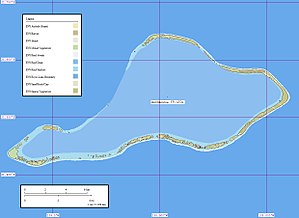Mururoa
| Mururoa | ||
|---|---|---|
| NASA image of Mururoa | ||
| Waters | Pacific Ocean | |
| archipelago | Tuamotu Archipelago | |
| Geographical location | 21 ° 51 ′ S , 138 ° 56 ′ W | |
|
|
||
| Number of islands | over 30 | |
| Land area | 15 km² | |
| Lagoon area | 148 km² | |
| Residents | uninhabited | |
| Map of Mururoa | ||
Mururoa (actually Moruroa ; in the local language roughly: "big secret") is an approximately 300 square kilometer, uninhabited atoll in the South Pacific , which has been known as the nuclear weapons test site in France since 1966 .
location
Mururoa is located in the southeast of the Tuamotu Archipelago , which is part of French Polynesia . Mururoa belongs to the municipality of Tureia . The atoll was discovered in 1767 by Philipp Carteret on the HMS Swallow for Europe and originally called the Bishop of Osnaburgh Island.
Nuclear tests
From 1966 to 1996, a total of 188 atomic bombs were detonated on Mururoa, 41 of them in the atmosphere and 147 underground. The first above-ground nuclear weapon test took place on July 2, 1966 under the code name " Aldébaran ".
On September 7, 1995, despite international protests, a further series of tests by France led to serious unrest in Tahiti . After worldwide protests, the explosions are now being simulated on the computer. In 2000 the French withdrew from the atoll. Mururoa is still a restricted area today . Large amounts of radioactive waste are stored there in around 140 boreholes .
See also
- Gambier Islands
- Fangataufa - France's second atoll for nuclear weapons tests
Web links
- Deutschlandfunk: Atomic aftershocks in the Pacific. The consequences of the French nuclear tests on Mururoa
- Nuclear weapons A – Z: Moruroa Atoll
Individual evidence
- ↑ Deutschlandfunk.de , " Background " , July 1, 2016, Suzanne Krause: Radiant contaminated sites in Polynesia (July 2, 2016)
- ↑ atomwaffena-z.info : Moruroa Atoll ( Memento from June 20, 2009 in the Internet Archive ) (October 28, 2010)
- ↑ Augsburger Allgemeine of September 7, 2010, column Das Datum
- ↑ France urged to clean up deadly waste from its nuclear tests in Polynesia theguardian.com, accessed on March 28, 2019



